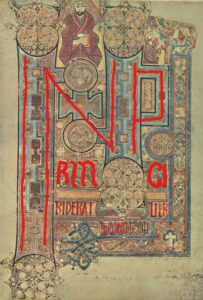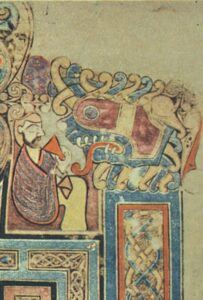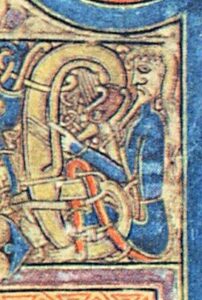The Book of Kells: Image and Text / The In principio Initial
- Elaine Harrington
- May 31, 2017
Student Exhibition, MA in Medieval History
The In Principio Initial

This post focuses on the text and imagery of folio 292r, which reads In principio erat verbum (‘In the beginning was the word’, John 1:1). The first three letters of the text are the largest and most elaborate. The I and N share a vertical shaft in the far left of the image. The diagonal of the N is then formed by linking that shaft to another by means of two circles and a cruciform shape. Sitting at the top of the image is a human figure robed in purple and clutching a book. The figure has been identified as a deacon holding a Gospel book, but also as an image of God the Father or the creating Logos. As pointed out by Małgorzata D’Aughton, the position of the figure above the circle parallels images of Christ seated on the globe of the world as in the fifth-century mosaic found in the baptistery of San Giovanni in Fonte, Naples or the later San Marco mosaic in Venice, which was inspired by a fifth- or sixth-century manuscript illustrations of the creation of the world. The iconography of the creation provides an appropriate context for the Kells page that glorifies the Word that existed at the beginning (John 1:1). The opening words of the Gospel of John evoke the opening words of the Book of Genesis that reads In principio creavit Deus caelum et terram (‘In the beginning God created heaven and earth’, Genesis 1:1) as the two texts emphasize the role of the word in the process of creation. In the Book of Genesis, God calls the universe into existence and then names all created things and beings (Genesis 1:1-31).

The letter P is the last of the three largest letters on the folio. The vertical shaft of this letter is joined to the second vertical of the N, while the loop is an independent rectangular shape. The second human figure is positioned above the loop of the P. He is shown seated, drinking from a cup, while a monstrous face of a lion, stares at him, mouth agape. This human figure has been identified as a Christian, who is saved from evil by drinking the Eucharistic wine. It may also, as argued by George Henderson, be a representation of Jesus in the Garden of Gethsemane, when he asks his disciple Peter, whether he, Jesus, can refuse to drink from the chalice prepared for him by the Father (John 18:11). This passage features at the opening of the Passion account and is directed at Peter as he attempts to prevent the arrest of Jesus.

The next line includes letters R, I, N, and C that are formed by serpent-like creatures and are relatively easy to read, as well as the letter I formed by a human figure grappling with the letter C. Imagery of wrestling or grappling in Biblical and patristic texts often relates to a struggle against evil. One such text is St Paul’s verse in the Epistle to the Ephesians that describes Christians as ‘wrestling not against flesh and blood but against the world rulers of present darkness’ (Ephesians 6:12). The Kells image may evoke this theme. The remaining letters that appear at the bottom of the page in two lines are the easiest to read; they spell out the letters P, I, O, E, R, A, T, V, E, R, B, U, and M. These letters are executed in a clear style without any decoration in a dark hue that contrasts them with the lighter background.

Connor White
Further reading
Krasnodębska-D’Aughton, Małgorzata, ‘Decoration of the In principio Initials in Early Insular Manuscripts: Christ as a Visible Image of the Invisible God’, Word and Image 18/2 (2012), pp. 105-122.
Farr, Carol Ann, The Book of Kells: Its Function and Audience (Toronto: University of Toronto Press, 1997).
Henderson, George, From Durrow to Kells: The Insular Gospel-Books, 650-800 (London: Thames and Hudson, 1987).
